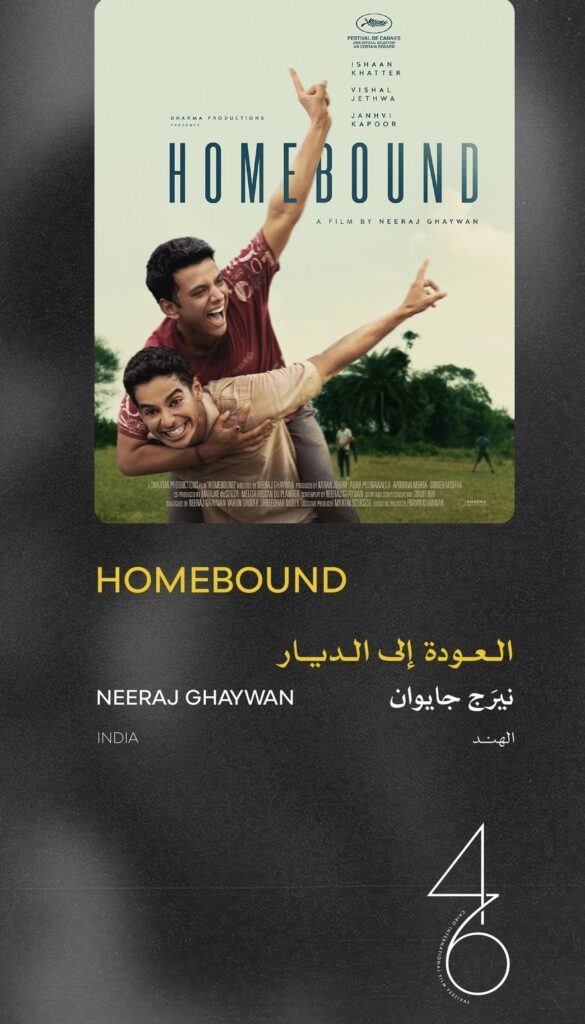Selected in the section Special Screenings (special screenings) of the 46th edition of the Cairo International Film Festival (CIFF), which takes place from November 12 to 21, 2025, Homebound by Neeraj Ghaywan continues an already prestigious career. The film had its world premiere at the Cannes Film Festival on May 21, 2025, in the Un Certain Regard section, where it was greeted with a nine-minute ovation. Despite this enthusiasm, the Cannes jury did not include it in its prize list, undoubtedly because of its melodramatic tone, a sensitivity which rarely appeals to Western juries. Today, this Hindi work returns to Cairo with growing recognition, having also been chosen to represent India at the 2026 Oscars in the Best International Film category.
The film tells the story of two childhood friends from a small village in northern India who dream of getting a job in the police, a symbol of the dignity they have always been denied. But as they get closer to their goal, insecurity and despair threaten the deep bond that unites them.
Ten years later Masaan, Homebound marks the return of Neeraj Ghaywan with a work of rare rigor, stripped of all complacency, where social matter becomes a fiction of great intensity. Directed and co-written by Ghaywan, produced by Dharma Productions (Karan Johar, Somen Mishra, Apoorva Mehta) and accompanied, at the writing and editing stages, by Martin Scorsese as executive producer, the film immediately asserts a singular artistic and moral ambition.
The story unfolds in two clearly distinct stages of unequal dramatic weight. The first part anchors the fiction in the daily life of the two protagonists: Shoaib (the young Muslim) and Chandan (the young Dalit), childhood friends from a village in northern India, brought together by the same dream, banal and radical at the same time — to join the police to escape precariousness and claim a form of social dignity. This opening sequence works the social meat of the film: conversations about life and the future, repetition of ordinary humiliations inflicted by the social order, small exchanges of affection and jealousy between friends, domestic scenes which reveal the balance of power within families and the village. Ghaywan takes the time to show the daily mechanics of relegation – stares, implicit refusals, missed opportunities – to establish the social configuration which will then make the second part tragic.
The second part changes when the COVID-19 pandemic hits: stranded far from home, the two young men are forced to hit the road again with thousands of other migrant workers. It is then that the film becomes a relentlessly slow road movie, a chronicle of exhaustion and institutional abandonment. Ghaywan, relying on the original journalistic material (report by Basharat Peer, 2020, which inspired the project), converts the migrants’ march towards the villages of origin into fiction, making visible the material impact of confinement – hunger, thirst, endless lines, administrative refusals, police checks, untreated illnesses. The camera doesn’t sugarcoat anything: fixed shots of waiting, close-ups of sunken faces, endless downtime that reflects wear and tear. Through this two-act construction, the film first shows what these men have to lose, then what society takes from them when it turns in on itself in times of crisis.


Beyond the dramatic power of the device, Homebound requires a precise sociological reading: anti-Muslim racism is not a one-off sequence but a systemic thread that runs through the fiction. Shoaib, as a Muslim character, suffers repeated doubts about his words, more frequent refusals of assistance, reduced visibility of the violence he suffers. Ghaywan does not dramatize Islamophobia with grand symbolic demonstrations; he shows it in its ordinary forms – administrative suspicions, small comments, silent relegations – and in their concrete consequences when the State disengages. This presence of anti-Muslim racism is combined, on screen, with other forms of stigmatization: religion becomes a factor multiplying obstacles in the face of the health crisis. More than an additional theme, religion structures distinct trajectories within the same exodus.
At the same time, the caste system is treated with the same analytical acuity: Chandan carries on his body and in his interactions the memory of a social assignment. The film shows caste not as sociological folklore but as an active infrastructure of contemporary social relations: access to work, to institutional dignity, police response, and distribution of aid during the crisis. The public humiliations inflicted on Chandan reflect a history of systemic devaluation whose effects are measured on a daily basis and in the administrative violence exercised in times of need. Ghaywan does not separate caste and religion into hermetic compartments; rather, it shows how these categories intersect and reorganize vulnerabilities in times of crisis.
The relationship between Shoaib and Chandan is the moral and emotional axis of the film. Their friendship is filmed without idealization: the camera captures the solidarity made up of tiny gestures – sharing a meal, protection from an attacker, words of comfort – but also the fractures that appear when one life seems to open to an opportunity and the other remains excluded. Ghaywan questions, without preaching, the price of individual mobility: the ascension offered to one can mean the erosion of a bond of fraternity built in survival. The moral question posed by the film is simple and terrible: what happens to solidarity when survival demands betrayal? Vishal Jethwa and Ishaan Khatter’s critically acclaimed performances bring these dilemmas to life and avoid excessive pathos.
On a formal level, Ghaywan chooses a sober but incisive staging: photography as close as possible to the faces, editing that lets you feel the duration, minimal music that avoids emphasis. This bias works because it perfectly matches the material of the film: the accumulation of small amounts of violence creates, by addition, an intensity heavier than any dramatic crescendo. A few “outburst” scenes – confrontations, public humiliations, moments of rupture – then emerge like tipping points, making people pay through emotion for what restraint had prepared.
Finally, Homebound asserts itself as a moral document of its time: far from flat denunciation, the film offers a comparison of the structures which produce vulnerability and the interior life of the characters who suffer it. By filming the pandemic as a catalyst for pre-existing exclusions, Ghaywan invites us to think of the crisis not as an isolated event but as a magnifying glass which reveals the hierarchies already at work. The film leaves little room for viewer comfort; it requires sustained attention and a willingness to recognize injustice as a system and not as a passing aberration.
Homebound is not an enjoyable film to watch in the entertaining sense of the term; it is necessary. Its success is due to the tenuous balance between documentary precision, strength of empathy and aesthetic demands. By devoting his attention to the small humiliations that make up the condition of the excluded, Neeraj Ghaywan constructs a contemporary fable – rooted in a real fact and made powerful by attention to details – which will remain a reference for thinking about the human impact of confinement and the social recompositions that it has revealed.
Neila Driss








